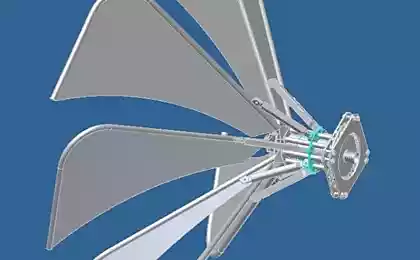554
In Mauritius, combine solar, wind and waves
Australian developer of marine energy company Carnegie Wave Energy embarked on a large-scale project on the island of Mauritius in the Indian Ocean, to set new standards in the decisions in micrometals (Microgrid), specifically designed for the high penetration of renewable energy sources.
"The project will clearly show Mauritius as the island can reach a very high degree of penetration of renewable energy sources. This will be used at the same time combined with waves of energy, solar photovoltaic panels, wind energy, energy storage system batteries and intelligent control system Microgrid, »said project manager Neil De Tisi magazine Renewable Energy World.
In carrying out its objectives, the project will demonstrate a range of innovative solutions. It will be built on the main island of Mauritius and in Rodrigues.

While Microgrid will serve to show how many renewable energy sources can be efficiently incorporated into the isolated network, it will also provide a test bed for the deployment of a new generation of energy capture technology waves Carnegie, CETO 6. Microgrid will also include a new desalination plant, which is currently being developed by Mak Water. Set it planned on the neighboring island Rodriguez.
scope of the project includes the provision of renewable energy, the development board is installed energy buoys for Mauritius, a brief description of the technical and financial ability of high penetration of renewable energy sources.
The introduction of wave energy technology Ceto 6
In an effort to replicate the success of its flagship project Island Garden in Australia, the developers plan to equip the microgrid with Ceto 6.
technology Generating components Ceto 6 offers fully submerged buoy tethered to the sea floor, with each unit rated power up to 1 MW. The technology will be installed in Blue Bay on the southeast coast of Mauritius - the site chosen as a result of collection of data on existing energy waves, indicating that there is the strongest wave in the region
.
In an effort to clarify its understanding of this energy potential, the Carnegie recently announced the successful implementation of the wave buoy monitoring, which will collect fresh data for about six months. Jessica Kolbusz, an engineer at the Carnegie Endowment, responsible for evaluation, with our magazine said that these data will "ensure the inspection of our existing models, but also more informed about the final design and scope micrometals.
"Evaluation of the wave resource capacity is a necessary first step. But the realization of these works simultaneously with the planning and development of micrometals installation of renewable energy map is really beneficial, as it gives the opportunity to develop highly efficient, climate-friendly solution with zero ", Kolbusz said.
It is currently unknown how much CETO 6 devices can be incorporated into the microgrid, but Carnegie optimistic about the potential of the project.
"The project is a really big step forward for the Carnegie, and offers an excellent opportunity to demonstrate the solution CETO wave energy 6," said Kolbusz.
The key development of Ceto 6 is that it includes a sophisticated hydraulic components of the generator directly to the offshore system. This eliminates the need for additional pipelines to shore and reduces hydraulic losses. In terms of infrastructure - on the beach, all you need is a cable
transmission ". Design Microgrid
Carnegie's partner in support of the project is an Australian company Energy Made Clean, which includes a portfolio of solar photovoltaic projects and microgrids connected to the network on a commercial scale.
Experience Carnegie believes De Tisi, is essential to the success of the project.
"The alliance with Carnegie Energy Made Clean means that after a phase of installation of solar photovoltaic panels with batteries and intelligent control system can be easily integrated energy converters waves at a later stage," said De Tisi.
The early stage of the project implemented with the financial support of grants from a partnership between the Australian and the Mauritius governments in the amount of AUS $ 800,000 (US $ 600,000).
Carnegie believes that the project will be very valuable, but achievable benchmark for other countries and regions, which should benefit from micrometals solutions.
"Great potential for this kind of solutions are being introduced to other island states, where there is a high demand for water and energy security», Kolbusz said. "Combining multiple renewable energy sources into the grid, as it is really well thought-out decision. This is especially true for Mauritius. "
"The project will clearly show Mauritius as the island can reach a very high degree of penetration of renewable energy sources. This will be used at the same time combined with waves of energy, solar photovoltaic panels, wind energy, energy storage system batteries and intelligent control system Microgrid, »said project manager Neil De Tisi magazine Renewable Energy World.
In carrying out its objectives, the project will demonstrate a range of innovative solutions. It will be built on the main island of Mauritius and in Rodrigues.

While Microgrid will serve to show how many renewable energy sources can be efficiently incorporated into the isolated network, it will also provide a test bed for the deployment of a new generation of energy capture technology waves Carnegie, CETO 6. Microgrid will also include a new desalination plant, which is currently being developed by Mak Water. Set it planned on the neighboring island Rodriguez.
scope of the project includes the provision of renewable energy, the development board is installed energy buoys for Mauritius, a brief description of the technical and financial ability of high penetration of renewable energy sources.
The introduction of wave energy technology Ceto 6
In an effort to replicate the success of its flagship project Island Garden in Australia, the developers plan to equip the microgrid with Ceto 6.
technology Generating components Ceto 6 offers fully submerged buoy tethered to the sea floor, with each unit rated power up to 1 MW. The technology will be installed in Blue Bay on the southeast coast of Mauritius - the site chosen as a result of collection of data on existing energy waves, indicating that there is the strongest wave in the region
.

In an effort to clarify its understanding of this energy potential, the Carnegie recently announced the successful implementation of the wave buoy monitoring, which will collect fresh data for about six months. Jessica Kolbusz, an engineer at the Carnegie Endowment, responsible for evaluation, with our magazine said that these data will "ensure the inspection of our existing models, but also more informed about the final design and scope micrometals.
"Evaluation of the wave resource capacity is a necessary first step. But the realization of these works simultaneously with the planning and development of micrometals installation of renewable energy map is really beneficial, as it gives the opportunity to develop highly efficient, climate-friendly solution with zero ", Kolbusz said.
It is currently unknown how much CETO 6 devices can be incorporated into the microgrid, but Carnegie optimistic about the potential of the project.
"The project is a really big step forward for the Carnegie, and offers an excellent opportunity to demonstrate the solution CETO wave energy 6," said Kolbusz.
The key development of Ceto 6 is that it includes a sophisticated hydraulic components of the generator directly to the offshore system. This eliminates the need for additional pipelines to shore and reduces hydraulic losses. In terms of infrastructure - on the beach, all you need is a cable
transmission ". Design Microgrid
Carnegie's partner in support of the project is an Australian company Energy Made Clean, which includes a portfolio of solar photovoltaic projects and microgrids connected to the network on a commercial scale.
Experience Carnegie believes De Tisi, is essential to the success of the project.
"The alliance with Carnegie Energy Made Clean means that after a phase of installation of solar photovoltaic panels with batteries and intelligent control system can be easily integrated energy converters waves at a later stage," said De Tisi.
The early stage of the project implemented with the financial support of grants from a partnership between the Australian and the Mauritius governments in the amount of AUS $ 800,000 (US $ 600,000).
Carnegie believes that the project will be very valuable, but achievable benchmark for other countries and regions, which should benefit from micrometals solutions.
"Great potential for this kind of solutions are being introduced to other island states, where there is a high demand for water and energy security», Kolbusz said. "Combining multiple renewable energy sources into the grid, as it is really well thought-out decision. This is especially true for Mauritius. "
Delicious cheese cakes stuffed with dried apricots
IMPORTANT! Effect of the tablet on the brain child























